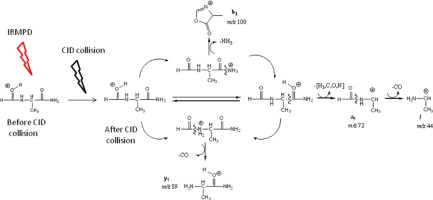Accueil du site > Production scientifique > Gas-phase collision induced dissociation mechanisms of peptides : Theoretical and experimental study of N-formylalanylamide fragmentation
Gas-phase collision induced dissociation mechanisms of peptides : Theoretical and experimental study of N-formylalanylamide fragmentation
Date de publication: 1er février 2013
D. Ortiz, P. Martin-Gago, A. Riera, K. Song, J.Y. Salpin, R. Spezia
International Journal of Mass Spectrometry 335 33–44 (2013). DOI
Travail réalisé sur le site de l’Université Paris Sud.
Abstract

In order to shed light on the fragmentation mechanisms occurring during the collision induced dissociation (CID) of peptides in the gas phase, we have studied a model system, the N-formylalanylamide (HCO-Ala-NH2), by coupling experimental and theoretical methods. In particular, we have addressed two different questions arising in such experiments : (i) what is (are) the structure(s) of the ion before collision, and (ii) what are the fragmentation mechanisms occurring after collision with the target gas. For the first question, we coupled the potential energy surface (PES) study done by means of density functional theory (DFT), with Infra Red Multiple Photon Dissociation (IRMPD) spectroscopy. For the second problem, which is actually the main topic of the present work, we coupled quantum mechanics plus molecular mechanics (QM + MM) direct chemical dynamics simulations with tandem mass spectrometry (MS/MS). In addition, in order to better delineate the fragmentation mechanisms and validate those proposed by simulations, isotopic labeling experiments using 2H and 13C were performed. Thanks to the interplay between simulations and experiments, it was possible to successfully identify the fragmentation pathways leading to b1, y1, a1 and immonium ions. Our mechanisms support the “mobile proton” picture that is supposed to trigger the peptide fragmentation in the gas phase, confirming, from a chemical dynamics point of view, previous theoretical and experimental studies on similar systems.








